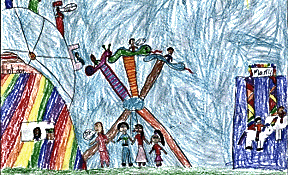


|
The question whether distance education will effectively bridge financial gaps and educational distances (disparities) or whether it will distance educators and students from each other is crucial to the current debate evolving around distance education. Many promoters of distance education point out that technology can be an effective and cheaper way to help people learn. For example, increased enrollment demands and declining state revenues played a major role in the development of plans to establish a Virtual University in the western states of the U.S. Supporters of the argument of cost-effectiveness point out that the entire Education Network of Maine cost less to create than one new high school. However, traditional cost-benefit studies may be difficult, if not impossible, to apply to the area of distance education. Costs are not intrinsic to the technology but a result of decisions made by program managers. The costs do not only depend on the number and type of technical staff employed, but also on the location, the time during which a course is provided (peak hours or off-peak?) and the subject area and extensiveness of the program. Educators promoting new media technologies have praised them as a viable alternative to traditional teaching and learning models. Multimedia computing systems are seen as a promising possibility for designing learner-centered, information-rich environments; these environments are said to give students control over currently undervalued visual-spatial, interpersonal and kinesthetic ways of solving problems and to provide an electronic platform for collaborative exploration and the social construction of knowledge. Today's public literacy is often described as based on a pedagogy that is characterized by mixed media and the carefully coordinated use of sight, sound and print. Models of education that incorporate the new technologies suggest that a definition of literacy that leaves out the full range of media may widen the gap between schools and the abilities of students as well as developments in the broader culture. Multimedia systems are seen as a useful means to help teachers to bridge the gap between the schools and the highly visual and auditory culture in which students are immersed today. This shift in pedagogy has gained momentum from positive research findings and decreasing hardware and software costs.  Critics of this model point to two major risks--that the emphasis upon visual material may compromise the efficacy of print media, and that the disembodiment of the learning process brought about by the nature of the technologies could atrophy learner socialization skills. However, promoters reply, the scenario of 350 Students taught by a professor who will never get to know their name over the course of the semester is not a drawback that only applies to distance education, but simply a worst-case-scenario of higher education that might occur in many universities. Some educators with experience in distance education programs point out that there seems to be more interaction and bonding between the students at a remote site than between those in a classroom. Evaluating the benefits of distance education is always a question of carefully considering the educational options and financial possibilities given at a certain place and time. A study of existing distance education programs and their respective success may provide more insight than a traditional cost-benefit study. (cf. http://www.yahoo.com/Education/ and http://www-distlearn.pp.asu.edu/related_links.html). The following examples of some of the currently existing programs and projects may provide some clues on what distance education has to offer.
Utah State University and the University of Utah created a unique collaborative distance education program to certify rural personnel in early childhood special education in Utah. In 1994, the state of Utah required that hose who provide services to Utah's young children with disabilities and their families had to be certified in early childhood special education or be enrolled in an approved program of studies by June of 1995. However, only two institutions of higher education in Utah are approved to recommend this teaching certificate and both of them are located along the populated Wasatch front. Geographic isolation from these programs posed a major problem for personnel in rural areas of the state. To address this problem, the Collaborative Early Childhood Special Education Project (CECSEP) was created. CECSEP includes Utah State University and University of Utah and the State Office of Education. Cyndi Rowland, David Decker, and Sarah Rule from Utah State University, and Joan Sebastian from the University of Utah are among those responsible for the development of CECSEP. The project combines distance technology, advisor contacts and local mentors to prepare personnel for certification.Courses have been adapted into self-study modules that include print, video, and CD-ROM materials. Once students have demonstrated mastery of the module content (through a self-evaluation that is electronically transferred to the instructor) they participate in a real-time interactive video broadcast (EDNET). The broadcast allows them to apply and integrate the content through discussions, case studies, role plays, cooperative exercises, and presentations. A home page on the WWW (http://www.cecsep.usu.edu/) provides students and prospective students with general program information and information about specific courses, sequences of courses, and financial assistance.
|